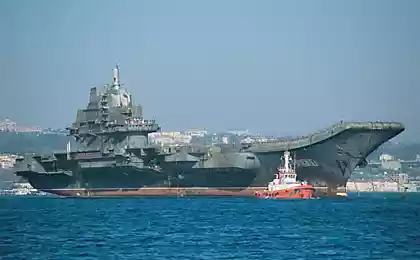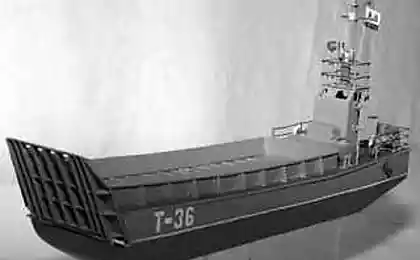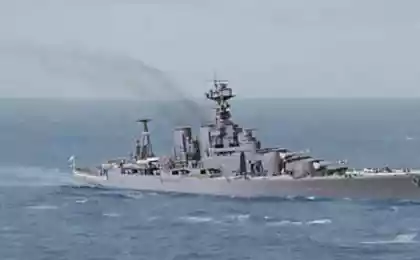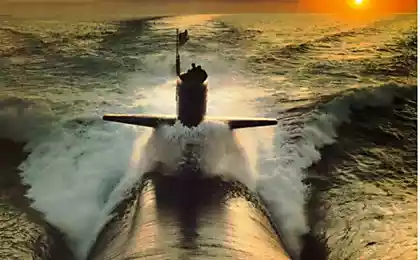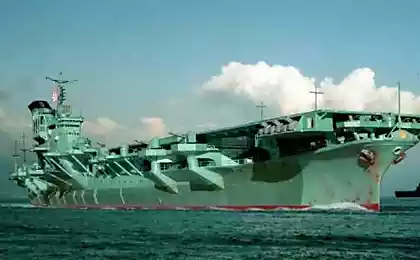2038
Underground carrier Threads
Recent political events in the order returned Russian armed forces unique polygon thread, built in the Crimea, shortly before the collapse of the USSR. At the time, the Soviet Union had extensive development plans aircraft carrier fleet. Useful if NITKA now?
Ground testing training complex aviation became colloquially simply magnified threads (and lean as a feminine noun). This became possible after the abbreviation of NIUTKA excluded "Y" - the letter to suggest that this was a complex (as, indeed, and still is) still learning.
9 photos
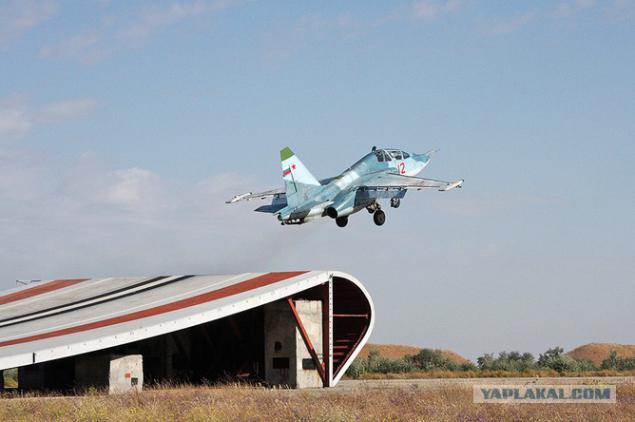
The plan to build the future THREAD was approved April 30, 1976 decree of the CPSU Central Committee and USSR Council of Ministers in the framework of the planned program of construction of two heavy cruisers with air armament project 1153. These ships (which had not been born, buried restructuring) to be fitted with nuclear power plants, catapults and arresting gear. The ships had to carry 70 different types of aircraft, including heavy airborne patrol aircraft Yak-44RLD (the analogue of the American AWACS). A government decree proactive creation of ground training complex, capable of solving all the issues related to construction and operation of future ships. The first was supposed to be a full-scale ground prototype aircraft carrier. In the world at that time there was only one such complex, and it belonged to the United States. There, namely in Lakehurst (NJ), and went to Navy Commander Admiral Gorshkov with the commander of naval aviation General Mironenko. The fact that they were able to see and learn there, much clearer. Vyrisovalas general concept of the complex. And the work began. Design and build Threads same bureaus and factories that created the carriers to the sea - Nevsky PKB and the Black Sea Works (here complex was called the order 705). Very great was the role in the creation of the Central Research Institute of Leningrad THREAD marine engineering and Proletarian factory. It is entrusted to them to develop, manufacture, assemble directly on the complex and establish its key components such as the steam catapult and arresters, first created in the USSR.
The place for the construction of the complex not chosen randomly. The village is situated at the banks Novofedorivka Kalamitsky gulf of the Black Sea, 7 km from the Crimean resort of Saki. Advantages of it was that the multi-ton hull structures of the complex, manufactured in Nikolaev (their total weight exceeds 12 000 tonnes) delivered to the construction site of the short sea route. The proximity of the sea was good for the fact that, flying from the deck of the thread plane immediately turned out over the sea, as during takeoff from an aircraft carrier coming. And the wind rose in the area favored the rise - in fact land the aircraft carrier could not turn around in the wind. Finally, the sea easily ensured Threads huge amount of water needed to cool the various components and operation of steam plants.
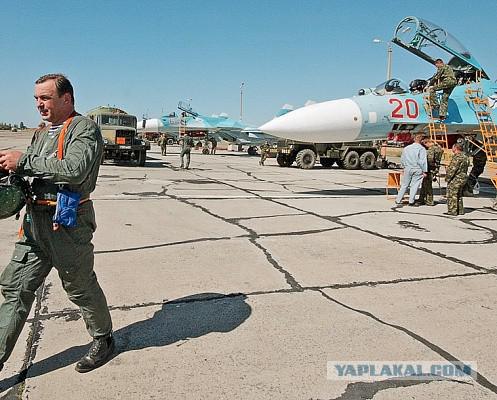
How does NITKA
Thread - this is a prototype Ground Attack aircraft carriers, deeply buried all three of his deck. The compartments of the "ship" were performed in the same manner as that of being built on the slipway Nikolaev Chernomorzavoda carrier. True, there are comfortable wardroom, gym and much more, designed for everyday life of sailors under the ocean trips. All the space under the upper deck given engineering.
The major innovations that have been practicing on a few blocks of the thread were arresters, dispersal device, trampolines and opto-electronic system of planting "Luna-3M".
Arresting gear are four heavy-duty steel cable stretched across the aft landing deck at intervals of 13 m. Complementing their emergency chain and nylon net-catcher on the nose cut the deck. Heart aerofinishernoy system - brake machine located in a special room below deck. This powerful unit weight below 100 m based on the principle of displacement of the working fluid from the brake cylinder to the pressure accumulator via a throttle valve, adjustment of which provides the desired braking force on the piston rod. Each has its own cable arresting gear brake the car. Brake cylinders for almost a half-meter diameter, have a length of 6 m. With their operating rods are connected through cables tackles. Aircraft landing gears special placed in the aft portion of hook (hook) and rope, lifting it about 0, 3 m above the deck drags. Now comes in the brake machine, providing for two seconds to stop the aircraft on the run in a few tens of meters. On the number of energy quenching brake machine, can be judged by the fact that the working fluid in its cylinders in just 2 heated to 110 ° C. Testing and Test aerobatsplanes initially performed using load trucks imitators (weighing from 14 to 27 m) and the upper unit. Only after successful completion of a landing on the arresters were made aircraft.

Dispersal device serves TSNIISM developed and manufactured Proletarian plant in Leningrad steam catapult. There were three similar pattern holds, two of which were intended for the aircraft carrier under construction "Ulyanovsk". Third catapult was tested on a string itself, and participated in working out aerobatsplanes. Catapult, known as product "Svetlana-1M", is to locate under the upper deck of the assembled sections slotted cylinder length of 90 m and a diameter of more than half a meter. Rigidly connected to the piston of the catapult shuttle through the cracks in the cylinder and the deck comes out, which must adhere to the nose gear which starts the aircraft. The cylinder is equipped with a complex system of sealing cracks, minimizing loss of steam supply, and also located in the end section of the hydraulic brake device. This is also very difficult to stop a rushing unit provides a speed of 250 km / h, the shuttle piston assembly weighing 5 tons, after separating from his landing gear or loading trolley. Braking distance when this is placed in the 1 to 5 m. The working body of the catapult is superheated steam supplied from cylinders, accumulators. Steam supply system is made based on an ordinary ship's boiler furnace, burnt every hour to 1 ton of fuel oil. On each "shot" catapult consumed 800 kg of steam. Also catapult steam used for other units thread. The exhaust steam is led into the condensers where 1, 5-meter tube fed seawater from specially constructed for this intakes.
Although the catapult actually proved its compliance TK planes on a string with it did not take off - primarily because the aircraft suitable for catapult launch in Russia yet. In this connection, a thread was successfully worked out another way to take off - jumping. Beginning was made with the angle of ascent ramp 8, 5 °, designed to simplify the start energy saving vertical takeoff aircraft Yak-41. Later, the angle of ascent ramp was increased to 14 °. This is the springboard for up to takeoff MiG-29K and Su-33, which is made on the deck until our sole shock aircraft carrier "Admiral Kuznetsov".
All new
First built complex obkatali using unmanned vehicles. Manned flights began in the summer of 1982. August 21 on the first takeoff of the MiG-29 made a test pilot A. Fastovets, a week later it was followed by a manned N. Sadovnikov Su-27. Only 31 August 1984 test pilot V. Pugachev made the first landing on a string using arresting gear system and "Luna-3M". Prior to 1988, were held hundreds of takeoffs made in different weather conditions.
In December 1988 the first test pilots Votintsev and twist performed on the complex aerofinishernoy landing on the Su-25UTG. Preparations have begun for the combatant pilots. By the results of working out on a thread were fundamental decisions on the design of the ship under construction. From catapults yet refused, and in the bow deck is parabolic ramp with an angle of 14 °.
Victim policy
But came the alteration, and then the collapse of the USSR. Ukraine became "independent", the Black Sea and a thread mill remained in its territory. Since 1994, Russia was forced to rent a facility for education and training of its pilots, paying with his new owner of the spare parts. In 2008, the Russian pilots were excommunicated from the thread a penalty for the Black Sea Fleet participated in the conflict with Georgia. In September 2010, the ban was lifted, but at the same time raised the rent. Yet the flights resumed. But in the meantime Eyske already was building the Russian analogue thread. Now it is introduced into operation in July 2013. The first takeoff from the springboard of the new complex is the Su-25.
In their capacity exceeds the new simulator of the first line. In particular, it provides helicopter part mounted in the Sea of Azov. Through this simulator pilots will be able to practice taking off and landing of helicopters on the deck of aircraft carriers. On the ground (airborne) of the simulator uses an advanced management system landing "Luna-37".
In 2012, the Defense Ministry last time Ukraine has transferred about $ 1, 5 million in payment for services rendered earlier thread, and in September the 2013th officially reported that since 2014 no plans to use this complex. The situation changed dramatically after the return to the bosom of the Crimea Russia. Together with the peninsula back and thread. Nothing in it really has changed, after all these years it was used for training only nominally Russian pilots. But part of the complex aggregates requires thorough revision and a minimum of maintenance. In March of this year, the Main Staff of the Russian Navy said that the thread can expect a deep modernization of the project of the new Russian aircraft carriers are already developing Nevsky PKB. And this is understandable: after all, the construction of such a complex and expensive installations advisable only for states that are based strike aircraft-carriers.
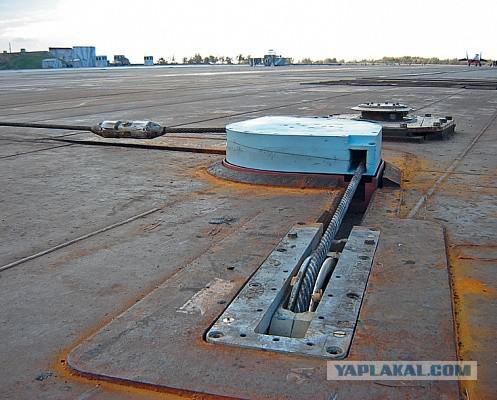
Expert Opinion
Polygons type thread, of course, very necessary to our naval aviation, at least up until we have a heavy aircraft-carrying cruiser and there are plans for further development of the aircraft carrier fleet. The fact that the rise from the deck and landing on her - a daunting task and in our country will be typed only three dozen pilots who know how to do. Their less than astronauts! Normal fighter takes off from the land aerodrome, has run 500-800 meters and running after landing - 500-600 m. Nothing like that in the conditions of an aircraft carrier, we can not afford. When springboard takeoff run can be only 95 meters, but after leaving the ramp plane still does not go to control speed, a second or two it moves along a ballistic curve and almost uncontrollable. Faced with this situation, the pilot must be very well prepared.
When landing on a land aerodrome, when in possession of the pilot is the strip length of 2500 m and a width of 48, the plane descends to it in a shallow glide path 2, 5 ° and passes successively equalization step, soak (this takes 300 meters) and a touchdown run. Marine fighter rushes to the deck by a steep glide path 4 °, while he should get into a rectangle measuring about 36 x 6 m and landing without aligning and holding. Besides the fact that it is also an incredibly difficult task, landing with a steep glide path and alignment without overloading is 4 units along the line head-pelvis. Then use the arresting gear at a distance slightly less than 100 m the aircraft must decelerate from 240 km / h to zero. This overload of the line back-chest 4, 5-5 units. Not surprisingly, the occupational disease carrier aviation pilots becomes detached retina.
And what is the cost of failure? If the pilot does not fall into a small rectangle that ensures proper fit, it can not only destroy expensive aircraft, but also, crashing into the side, sink the aircraft carrier. It is a huge responsibility, and, of course, before allowing pilots to take off and landing deck, they must train where undershoot, flight, landing a left or right of the goal does not lead to fatal consequences. And it's not just about training pilots, who had no previous experience with the aircraft carrier takeoff and landing on the deck, but also retraining already experienced pilots if the practice was adjourned.
Vladimir G. Dejneka
Colonel-General, Commander of the naval aviation of the Russian Navy in 1994-2000.
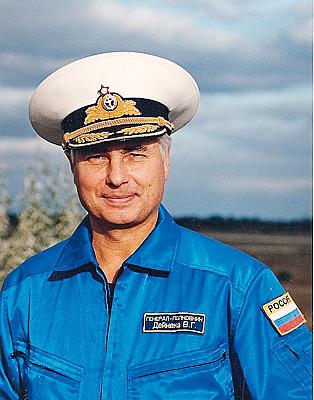
Scheme Landfill NITKA
1. The control tower
2. Starting Block BS-1
3. Track steam catapult
4. Starting Block BS-2 (underneath steam power plants)
5. Block aerobatsplanes BS-2-2
6. The space reserved for the second catapult
7. Runway with a springboard
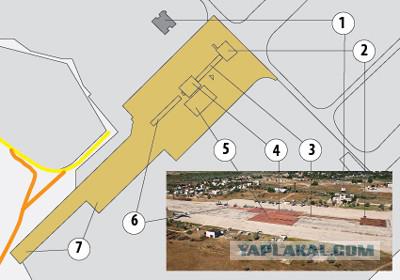
Similar polygons world
All aircraft carrier powers made sure that each pilot before attempting to land on an aircraft carrier, was a serious workout on the ground. The most active in this respect, China is developing.
US
No state of the world did not have and does not have today, so many aircraft carriers shock as the US. Only atomic monsters displacement of more than 100,000 tons (type Nimitz) in the ranks of ten. Each carrying 60-80 aircrafts of different classes. Already under construction should be improved series (type Gerald Ford). The Americans were the first and in the creation of the Engineering Center of Naval Aviation, designed for developing new technical solutions for the creation of aircraft carriers, as well as education and training deck aircraft pilots. The center, located near the town of Lakehurst, NJ, is based on the existing with 1930 base airships. Today it includes several complexes simulating full-scale flight deck aircraft carriers promising with the appropriate infrastructure (arresters, catapults, control systems and landing t. D.). The center provides takeoff and landing of all types of deck aerial vehicles (UAVs from light to heavy aircraft radar reconnaissance AWACS). Technical "highlight" of the Centre are functioning in his latest composition Mass driver for installation on aircraft carriers under construction.
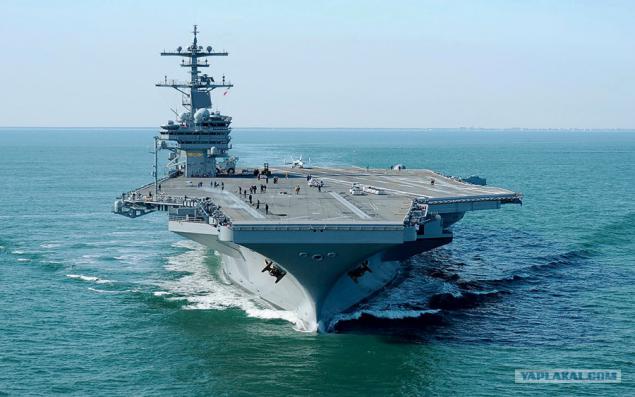
China
Immediately after the acquisition of an unfinished Soviet aircraft carrier based fighter and prototype T-10K (now the Su-33) China has begun to establish terrestrial prototype ship. Soon, a full-scale concrete aircraft carrier with a 300-meter flight deck and control tower rose near the city of Wuhan (Hubei Province). There have already started to land and take off the new Chinese carrier-based fighter J-15 (according to experts, is a pure clone of the Russian Su-33). Such rapid progress towards the creation of the Chinese ground complex largely contributed to their visits to the Mykolayiv Black Sea and Crimean plant thread, as well as lectures on the same topic, read in Wuhan invited there as chief designer of the Soviet steam catapults and aerobatsplanes Bulgakov. But Chinese engineers went further: having mastered the most advanced technology to create powerful linear motors, energy storage, and an electromagnetic pulse generator, they are almost at the same time the Americans were able to build a Mass driver having obvious advantages over steam. The length of the entire device is about 150 m, including electromagnetic track the order of 80 m. The parallel construction of new complexes that mimic the landing deck of an aircraft carrier, in the provinces of Shaanxi and Laonin. Their size will fit embarkation deck promising Chinese aircraft carriers, two of which should be ready in 2015.

India
The Indians, without further ado, my land complex (SBTF) made in the image of Russia being built in Eyske. The more that they recently entered into service an aircraft carrier "Vikramaditya" - is not nothing but a completely remodeled in Severodvinsk former Soviet heavy aircraft-carrying cruiser "Admiral Gorshkov" (formerly "Baku"), and take off his deck will be Russian MiGs and Su. All project documentation was developed complex Nevsky PKB. The flight deck of the complex is similar to said aircraft carriers, also with a springboard to 14 °. Located near the Indian NITKA sea - in the resort area of Goa. In 2013, began its pilot operation.
Posted in [mergetime] 1404045401 [/ mergetime]
UK
On the ground test-training complex of the country know very little. It was built in the central part of northern England, in the county of West Yorkshire near the ancient city of Bradford. The complex is equipped with steam catapults and arresting gear. Already in the 70s of last century, it passed the test deck fighters JaguarM-05 and later - manufactured in France, single and double deck fighter Rafale.
Source
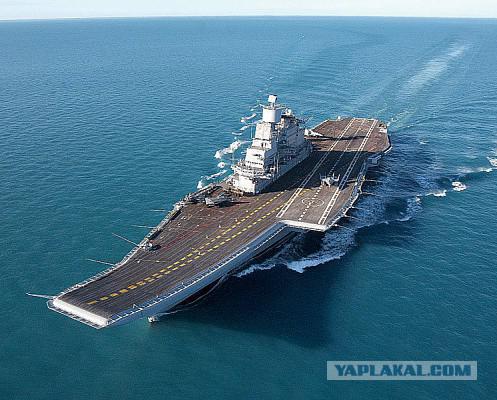
Ground testing training complex aviation became colloquially simply magnified threads (and lean as a feminine noun). This became possible after the abbreviation of NIUTKA excluded "Y" - the letter to suggest that this was a complex (as, indeed, and still is) still learning.
9 photos

The plan to build the future THREAD was approved April 30, 1976 decree of the CPSU Central Committee and USSR Council of Ministers in the framework of the planned program of construction of two heavy cruisers with air armament project 1153. These ships (which had not been born, buried restructuring) to be fitted with nuclear power plants, catapults and arresting gear. The ships had to carry 70 different types of aircraft, including heavy airborne patrol aircraft Yak-44RLD (the analogue of the American AWACS). A government decree proactive creation of ground training complex, capable of solving all the issues related to construction and operation of future ships. The first was supposed to be a full-scale ground prototype aircraft carrier. In the world at that time there was only one such complex, and it belonged to the United States. There, namely in Lakehurst (NJ), and went to Navy Commander Admiral Gorshkov with the commander of naval aviation General Mironenko. The fact that they were able to see and learn there, much clearer. Vyrisovalas general concept of the complex. And the work began. Design and build Threads same bureaus and factories that created the carriers to the sea - Nevsky PKB and the Black Sea Works (here complex was called the order 705). Very great was the role in the creation of the Central Research Institute of Leningrad THREAD marine engineering and Proletarian factory. It is entrusted to them to develop, manufacture, assemble directly on the complex and establish its key components such as the steam catapult and arresters, first created in the USSR.
The place for the construction of the complex not chosen randomly. The village is situated at the banks Novofedorivka Kalamitsky gulf of the Black Sea, 7 km from the Crimean resort of Saki. Advantages of it was that the multi-ton hull structures of the complex, manufactured in Nikolaev (their total weight exceeds 12 000 tonnes) delivered to the construction site of the short sea route. The proximity of the sea was good for the fact that, flying from the deck of the thread plane immediately turned out over the sea, as during takeoff from an aircraft carrier coming. And the wind rose in the area favored the rise - in fact land the aircraft carrier could not turn around in the wind. Finally, the sea easily ensured Threads huge amount of water needed to cool the various components and operation of steam plants.

How does NITKA
Thread - this is a prototype Ground Attack aircraft carriers, deeply buried all three of his deck. The compartments of the "ship" were performed in the same manner as that of being built on the slipway Nikolaev Chernomorzavoda carrier. True, there are comfortable wardroom, gym and much more, designed for everyday life of sailors under the ocean trips. All the space under the upper deck given engineering.
The major innovations that have been practicing on a few blocks of the thread were arresters, dispersal device, trampolines and opto-electronic system of planting "Luna-3M".
Arresting gear are four heavy-duty steel cable stretched across the aft landing deck at intervals of 13 m. Complementing their emergency chain and nylon net-catcher on the nose cut the deck. Heart aerofinishernoy system - brake machine located in a special room below deck. This powerful unit weight below 100 m based on the principle of displacement of the working fluid from the brake cylinder to the pressure accumulator via a throttle valve, adjustment of which provides the desired braking force on the piston rod. Each has its own cable arresting gear brake the car. Brake cylinders for almost a half-meter diameter, have a length of 6 m. With their operating rods are connected through cables tackles. Aircraft landing gears special placed in the aft portion of hook (hook) and rope, lifting it about 0, 3 m above the deck drags. Now comes in the brake machine, providing for two seconds to stop the aircraft on the run in a few tens of meters. On the number of energy quenching brake machine, can be judged by the fact that the working fluid in its cylinders in just 2 heated to 110 ° C. Testing and Test aerobatsplanes initially performed using load trucks imitators (weighing from 14 to 27 m) and the upper unit. Only after successful completion of a landing on the arresters were made aircraft.

Dispersal device serves TSNIISM developed and manufactured Proletarian plant in Leningrad steam catapult. There were three similar pattern holds, two of which were intended for the aircraft carrier under construction "Ulyanovsk". Third catapult was tested on a string itself, and participated in working out aerobatsplanes. Catapult, known as product "Svetlana-1M", is to locate under the upper deck of the assembled sections slotted cylinder length of 90 m and a diameter of more than half a meter. Rigidly connected to the piston of the catapult shuttle through the cracks in the cylinder and the deck comes out, which must adhere to the nose gear which starts the aircraft. The cylinder is equipped with a complex system of sealing cracks, minimizing loss of steam supply, and also located in the end section of the hydraulic brake device. This is also very difficult to stop a rushing unit provides a speed of 250 km / h, the shuttle piston assembly weighing 5 tons, after separating from his landing gear or loading trolley. Braking distance when this is placed in the 1 to 5 m. The working body of the catapult is superheated steam supplied from cylinders, accumulators. Steam supply system is made based on an ordinary ship's boiler furnace, burnt every hour to 1 ton of fuel oil. On each "shot" catapult consumed 800 kg of steam. Also catapult steam used for other units thread. The exhaust steam is led into the condensers where 1, 5-meter tube fed seawater from specially constructed for this intakes.
Although the catapult actually proved its compliance TK planes on a string with it did not take off - primarily because the aircraft suitable for catapult launch in Russia yet. In this connection, a thread was successfully worked out another way to take off - jumping. Beginning was made with the angle of ascent ramp 8, 5 °, designed to simplify the start energy saving vertical takeoff aircraft Yak-41. Later, the angle of ascent ramp was increased to 14 °. This is the springboard for up to takeoff MiG-29K and Su-33, which is made on the deck until our sole shock aircraft carrier "Admiral Kuznetsov".
All new
First built complex obkatali using unmanned vehicles. Manned flights began in the summer of 1982. August 21 on the first takeoff of the MiG-29 made a test pilot A. Fastovets, a week later it was followed by a manned N. Sadovnikov Su-27. Only 31 August 1984 test pilot V. Pugachev made the first landing on a string using arresting gear system and "Luna-3M". Prior to 1988, were held hundreds of takeoffs made in different weather conditions.
In December 1988 the first test pilots Votintsev and twist performed on the complex aerofinishernoy landing on the Su-25UTG. Preparations have begun for the combatant pilots. By the results of working out on a thread were fundamental decisions on the design of the ship under construction. From catapults yet refused, and in the bow deck is parabolic ramp with an angle of 14 °.
Victim policy
But came the alteration, and then the collapse of the USSR. Ukraine became "independent", the Black Sea and a thread mill remained in its territory. Since 1994, Russia was forced to rent a facility for education and training of its pilots, paying with his new owner of the spare parts. In 2008, the Russian pilots were excommunicated from the thread a penalty for the Black Sea Fleet participated in the conflict with Georgia. In September 2010, the ban was lifted, but at the same time raised the rent. Yet the flights resumed. But in the meantime Eyske already was building the Russian analogue thread. Now it is introduced into operation in July 2013. The first takeoff from the springboard of the new complex is the Su-25.
In their capacity exceeds the new simulator of the first line. In particular, it provides helicopter part mounted in the Sea of Azov. Through this simulator pilots will be able to practice taking off and landing of helicopters on the deck of aircraft carriers. On the ground (airborne) of the simulator uses an advanced management system landing "Luna-37".
In 2012, the Defense Ministry last time Ukraine has transferred about $ 1, 5 million in payment for services rendered earlier thread, and in September the 2013th officially reported that since 2014 no plans to use this complex. The situation changed dramatically after the return to the bosom of the Crimea Russia. Together with the peninsula back and thread. Nothing in it really has changed, after all these years it was used for training only nominally Russian pilots. But part of the complex aggregates requires thorough revision and a minimum of maintenance. In March of this year, the Main Staff of the Russian Navy said that the thread can expect a deep modernization of the project of the new Russian aircraft carriers are already developing Nevsky PKB. And this is understandable: after all, the construction of such a complex and expensive installations advisable only for states that are based strike aircraft-carriers.

Expert Opinion
Polygons type thread, of course, very necessary to our naval aviation, at least up until we have a heavy aircraft-carrying cruiser and there are plans for further development of the aircraft carrier fleet. The fact that the rise from the deck and landing on her - a daunting task and in our country will be typed only three dozen pilots who know how to do. Their less than astronauts! Normal fighter takes off from the land aerodrome, has run 500-800 meters and running after landing - 500-600 m. Nothing like that in the conditions of an aircraft carrier, we can not afford. When springboard takeoff run can be only 95 meters, but after leaving the ramp plane still does not go to control speed, a second or two it moves along a ballistic curve and almost uncontrollable. Faced with this situation, the pilot must be very well prepared.
When landing on a land aerodrome, when in possession of the pilot is the strip length of 2500 m and a width of 48, the plane descends to it in a shallow glide path 2, 5 ° and passes successively equalization step, soak (this takes 300 meters) and a touchdown run. Marine fighter rushes to the deck by a steep glide path 4 °, while he should get into a rectangle measuring about 36 x 6 m and landing without aligning and holding. Besides the fact that it is also an incredibly difficult task, landing with a steep glide path and alignment without overloading is 4 units along the line head-pelvis. Then use the arresting gear at a distance slightly less than 100 m the aircraft must decelerate from 240 km / h to zero. This overload of the line back-chest 4, 5-5 units. Not surprisingly, the occupational disease carrier aviation pilots becomes detached retina.
And what is the cost of failure? If the pilot does not fall into a small rectangle that ensures proper fit, it can not only destroy expensive aircraft, but also, crashing into the side, sink the aircraft carrier. It is a huge responsibility, and, of course, before allowing pilots to take off and landing deck, they must train where undershoot, flight, landing a left or right of the goal does not lead to fatal consequences. And it's not just about training pilots, who had no previous experience with the aircraft carrier takeoff and landing on the deck, but also retraining already experienced pilots if the practice was adjourned.
Vladimir G. Dejneka
Colonel-General, Commander of the naval aviation of the Russian Navy in 1994-2000.

Scheme Landfill NITKA
1. The control tower
2. Starting Block BS-1
3. Track steam catapult
4. Starting Block BS-2 (underneath steam power plants)
5. Block aerobatsplanes BS-2-2
6. The space reserved for the second catapult
7. Runway with a springboard

Similar polygons world
All aircraft carrier powers made sure that each pilot before attempting to land on an aircraft carrier, was a serious workout on the ground. The most active in this respect, China is developing.
US
No state of the world did not have and does not have today, so many aircraft carriers shock as the US. Only atomic monsters displacement of more than 100,000 tons (type Nimitz) in the ranks of ten. Each carrying 60-80 aircrafts of different classes. Already under construction should be improved series (type Gerald Ford). The Americans were the first and in the creation of the Engineering Center of Naval Aviation, designed for developing new technical solutions for the creation of aircraft carriers, as well as education and training deck aircraft pilots. The center, located near the town of Lakehurst, NJ, is based on the existing with 1930 base airships. Today it includes several complexes simulating full-scale flight deck aircraft carriers promising with the appropriate infrastructure (arresters, catapults, control systems and landing t. D.). The center provides takeoff and landing of all types of deck aerial vehicles (UAVs from light to heavy aircraft radar reconnaissance AWACS). Technical "highlight" of the Centre are functioning in his latest composition Mass driver for installation on aircraft carriers under construction.

China
Immediately after the acquisition of an unfinished Soviet aircraft carrier based fighter and prototype T-10K (now the Su-33) China has begun to establish terrestrial prototype ship. Soon, a full-scale concrete aircraft carrier with a 300-meter flight deck and control tower rose near the city of Wuhan (Hubei Province). There have already started to land and take off the new Chinese carrier-based fighter J-15 (according to experts, is a pure clone of the Russian Su-33). Such rapid progress towards the creation of the Chinese ground complex largely contributed to their visits to the Mykolayiv Black Sea and Crimean plant thread, as well as lectures on the same topic, read in Wuhan invited there as chief designer of the Soviet steam catapults and aerobatsplanes Bulgakov. But Chinese engineers went further: having mastered the most advanced technology to create powerful linear motors, energy storage, and an electromagnetic pulse generator, they are almost at the same time the Americans were able to build a Mass driver having obvious advantages over steam. The length of the entire device is about 150 m, including electromagnetic track the order of 80 m. The parallel construction of new complexes that mimic the landing deck of an aircraft carrier, in the provinces of Shaanxi and Laonin. Their size will fit embarkation deck promising Chinese aircraft carriers, two of which should be ready in 2015.

India
The Indians, without further ado, my land complex (SBTF) made in the image of Russia being built in Eyske. The more that they recently entered into service an aircraft carrier "Vikramaditya" - is not nothing but a completely remodeled in Severodvinsk former Soviet heavy aircraft-carrying cruiser "Admiral Gorshkov" (formerly "Baku"), and take off his deck will be Russian MiGs and Su. All project documentation was developed complex Nevsky PKB. The flight deck of the complex is similar to said aircraft carriers, also with a springboard to 14 °. Located near the Indian NITKA sea - in the resort area of Goa. In 2013, began its pilot operation.
Posted in [mergetime] 1404045401 [/ mergetime]
UK
On the ground test-training complex of the country know very little. It was built in the central part of northern England, in the county of West Yorkshire near the ancient city of Bradford. The complex is equipped with steam catapults and arresting gear. Already in the 70s of last century, it passed the test deck fighters JaguarM-05 and later - manufactured in France, single and double deck fighter Rafale.
Source



